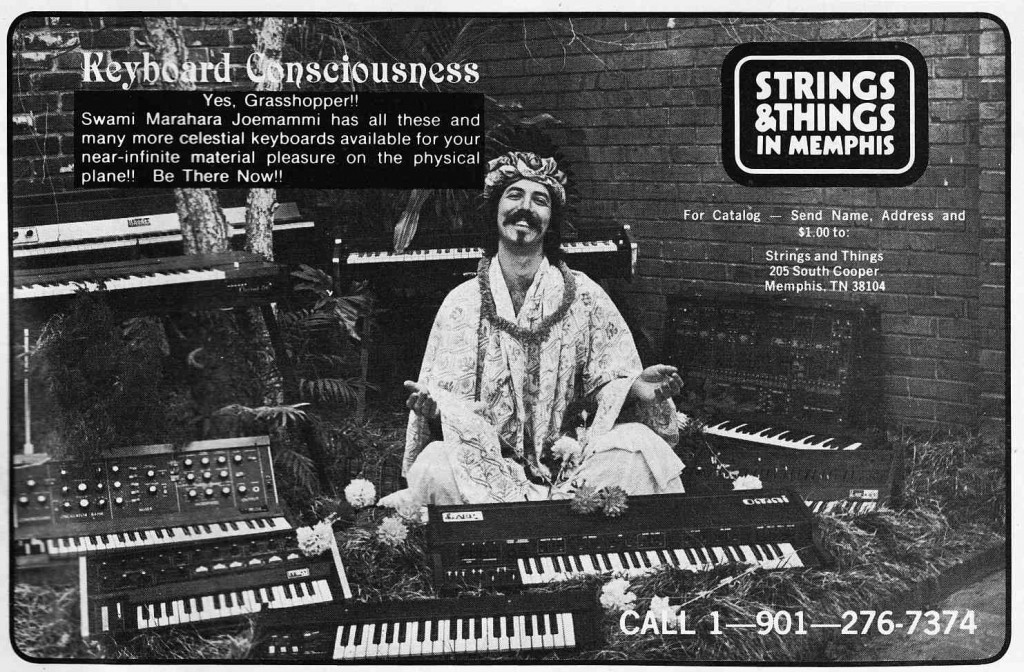 Strings & Things Memphis advert for keyboards circa 1977.
Strings & Things Memphis advert for keyboards circa 1977.
Been looking through some mid-70s issues of “Contemporary Keyboard” (h.f. “CK”) magazine. CK later became simply “Keyboard,” which is still in publication; it’s part of the GUITAR PLAYER family of publications. NEways… 1976/7 was an interesting time in the development of keyboard instruments. Affordable polyphonic (IE., you can play more than one note at a time) synthesizers were still a few years away, and realistic-sounding electronic pianos were still about a decade away. So what you had was a very mixed bag of Electronic Pianos and ‘String Synthesizers,’ which are both basically hyped-up electric organs; some still-useful electro-acoustic instruments; and a pretty wide range of pretty experimental synthesizers, many from small manufacturers that didn’t stay around very long. In about 6 years this would all be blown away by advanced Japanese synths with built-in programming, patch memory, and all with polyphony; the Roland/Korg/Yamaha DX7 era; and this too would fall at the hands of the dreaded Korg M1, which ushered in the Rompler era. Anyone out there using an M1 lately?
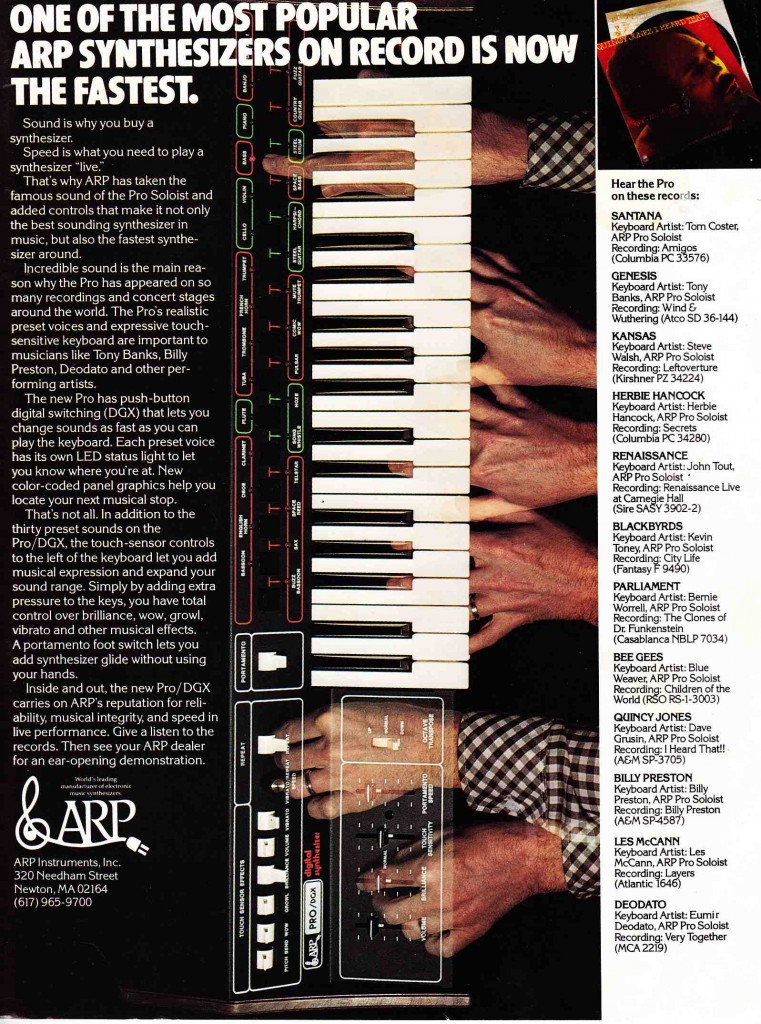 The ARP pro-soloist, typical of the ‘preset’ synths of the era; preset synths offered interfaces optimized for live-performance rather than endless tweaking in the studio.
The ARP pro-soloist, typical of the ‘preset’ synths of the era; preset synths offered interfaces optimized for live-performance rather than endless tweaking in the studio.

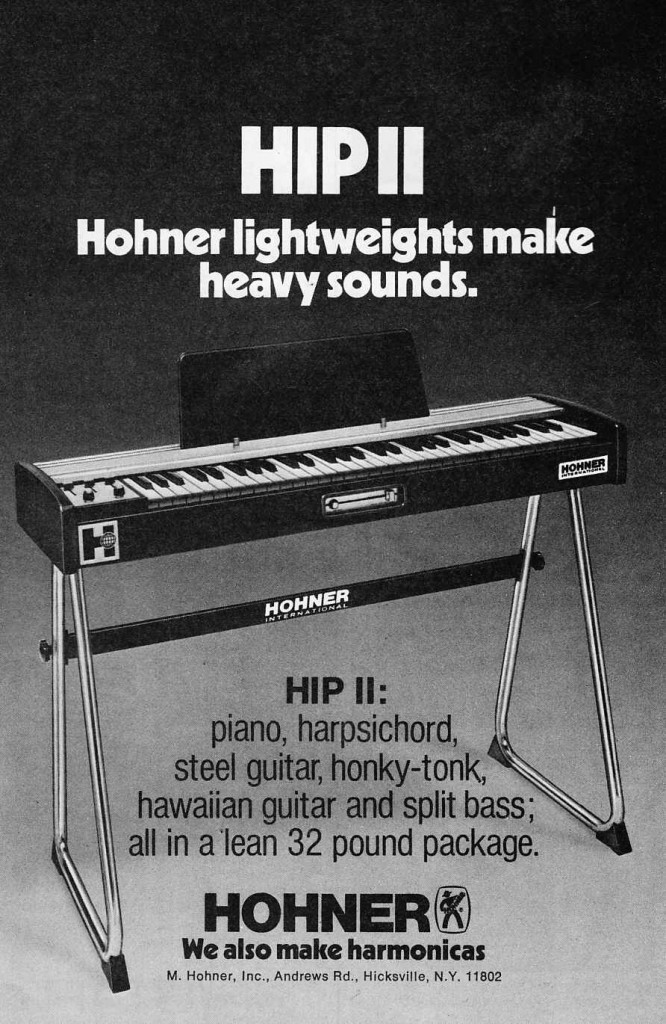
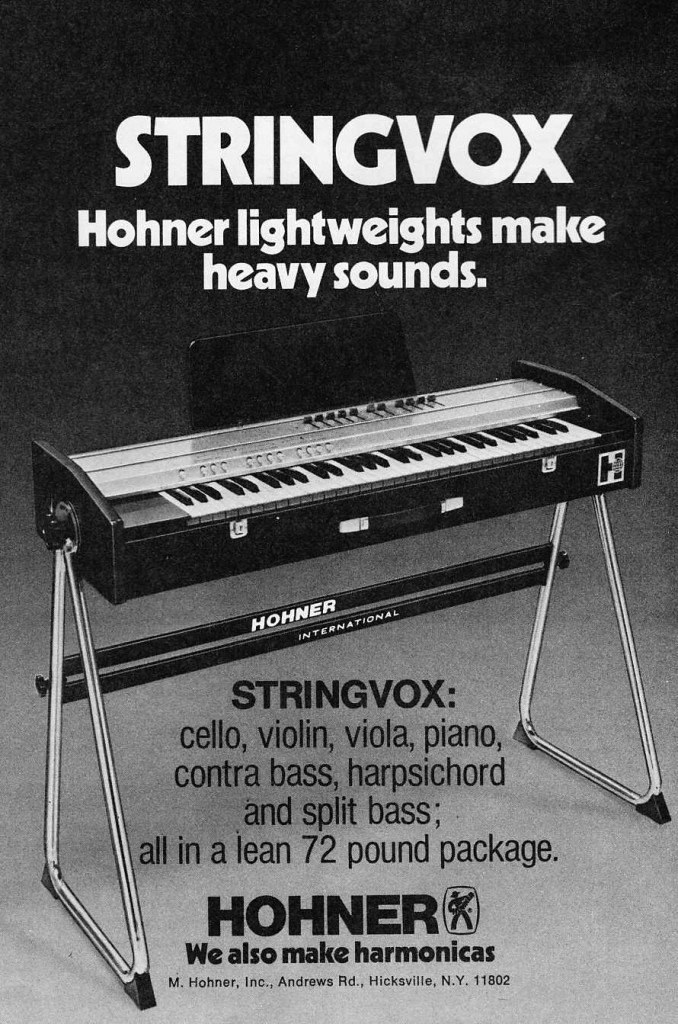 The Hohner Clavinet, HIP II, and Stringvox. The Clavinet has attained classic status, and many are still in use; not so sure about the HIP II and Stringvox.
The Hohner Clavinet, HIP II, and Stringvox. The Clavinet has attained classic status, and many are still in use; not so sure about the HIP II and Stringvox.
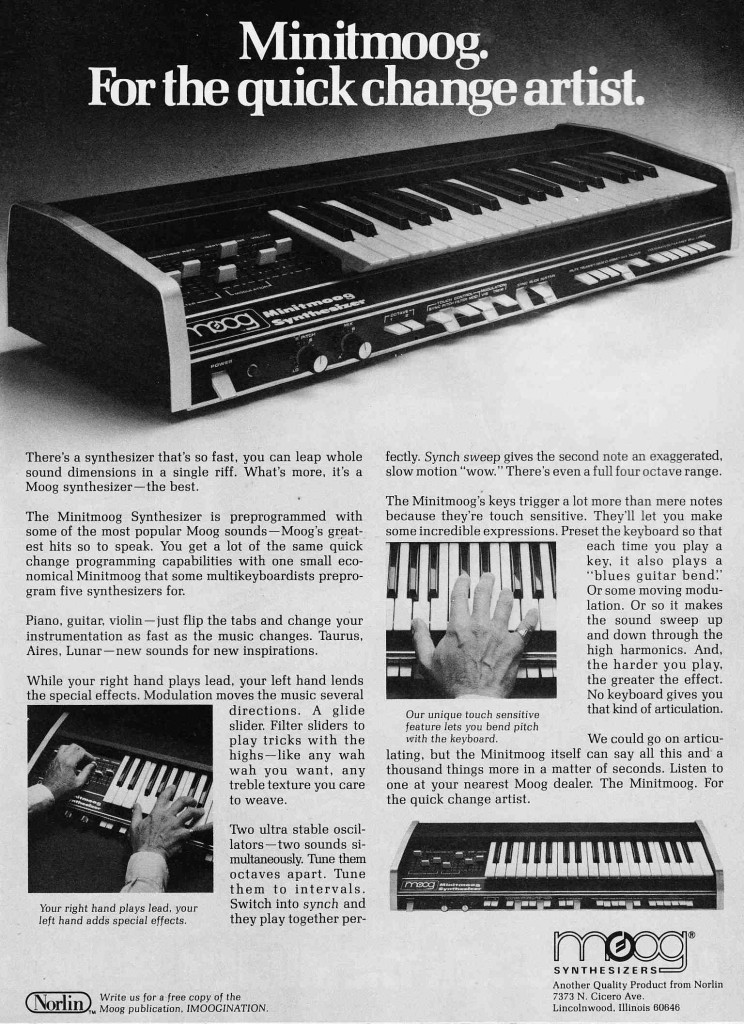
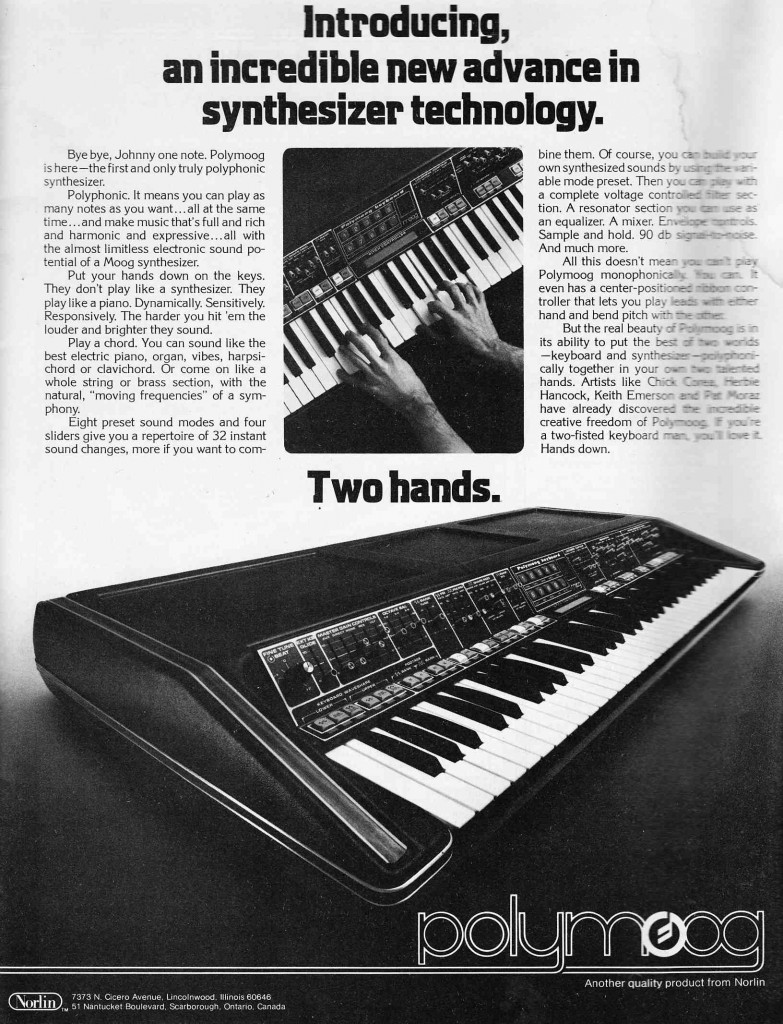 A couple of Moogs from different ends of the spectrum. The Minitmoog was a ‘preset’ synth; the Polymoog was not a true synth; it was closer to an organ in terms of its basic operating principle.
A couple of Moogs from different ends of the spectrum. The Minitmoog was a ‘preset’ synth; the Polymoog was not a true synth; it was closer to an organ in terms of its basic operating principle.
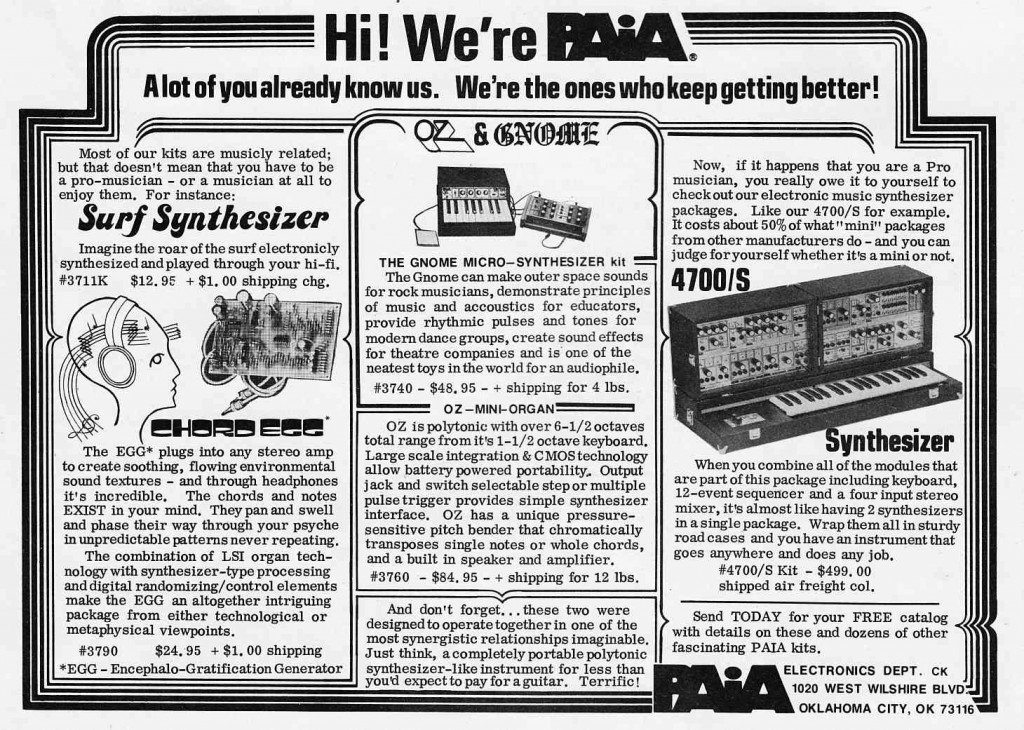 A few Paia synth-kit offerings of the mid 70s: the Surf Synthesizer, The Gnome, and the classic 4700. See this link for previous PAIA coverage on PS dot com.
A few Paia synth-kit offerings of the mid 70s: the Surf Synthesizer, The Gnome, and the classic 4700. See this link for previous PAIA coverage on PS dot com.
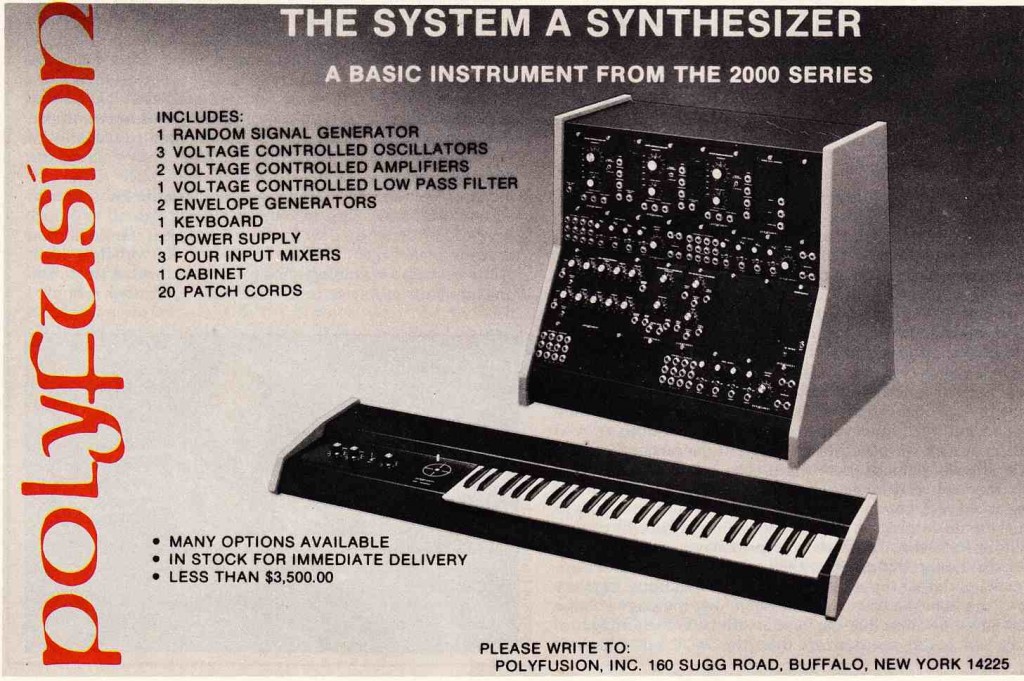 An advert for the Polyfusion System A. See this link for previous coverage of the Polyfusion line.
An advert for the Polyfusion System A. See this link for previous coverage of the Polyfusion line.
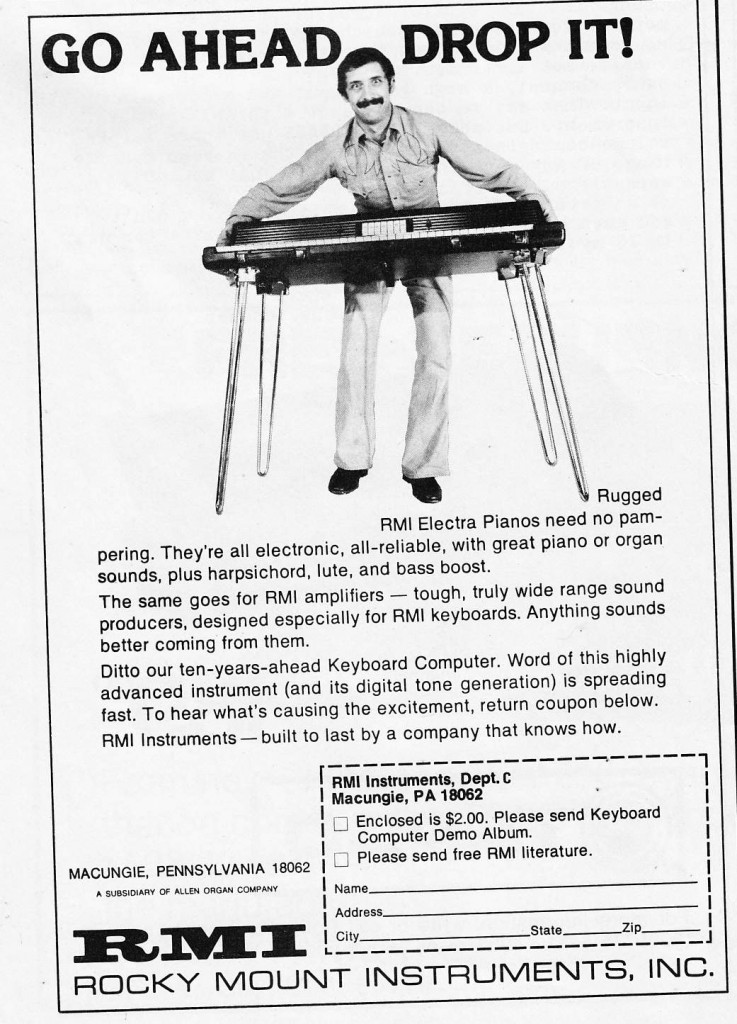 The RMI Electra Piano. When we were growing up in the late 80s/early 90s, ‘electric pianos’ like these were about fifty bucks or less; no one wanted them, and that has not changed. They sound pretty awful but they’re still heavy and cumbersome!
The RMI Electra Piano. When we were growing up in the late 80s/early 90s, ‘electric pianos’ like these were about fifty bucks or less; no one wanted them, and that has not changed. They sound pretty awful but they’re still heavy and cumbersome!
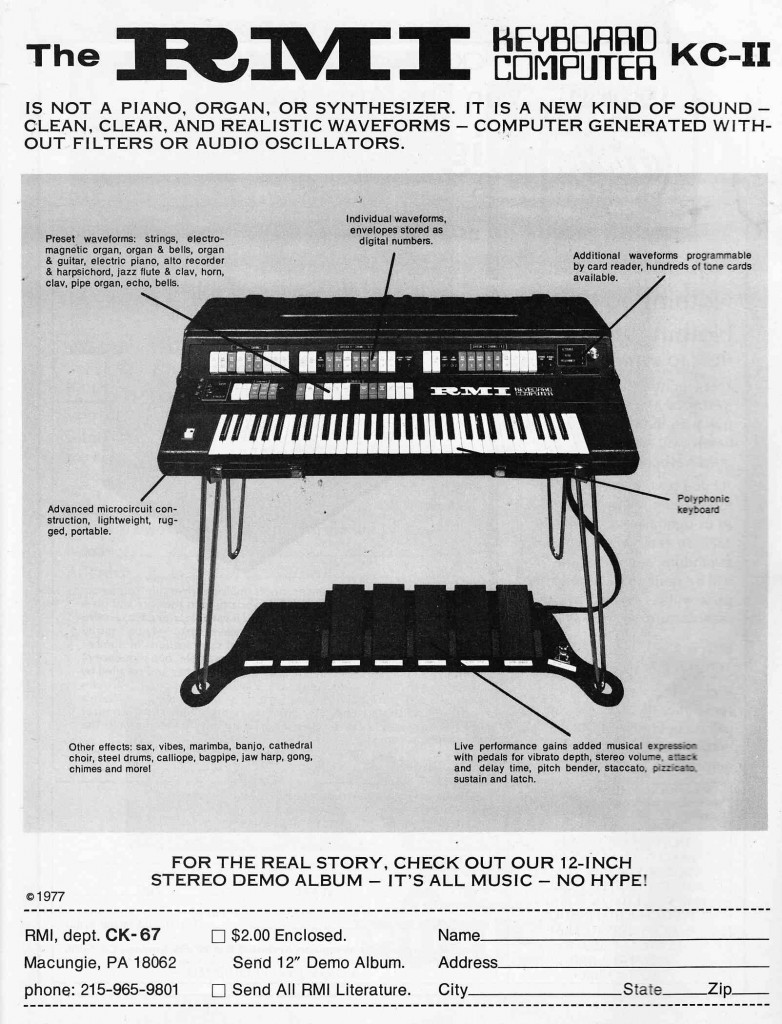 The RMI KC-II Keyboard Computer. From what I gather, this device is essentially a RAMpler; not too different in basic principle from the epic Synclavier in that the user could input waveforms which would then be manipulated. This thing apparently cost $4700 which means that… yeah… there ain’t too many out there.
The RMI KC-II Keyboard Computer. From what I gather, this device is essentially a RAMpler; not too different in basic principle from the epic Synclavier in that the user could input waveforms which would then be manipulated. This thing apparently cost $4700 which means that… yeah… there ain’t too many out there.
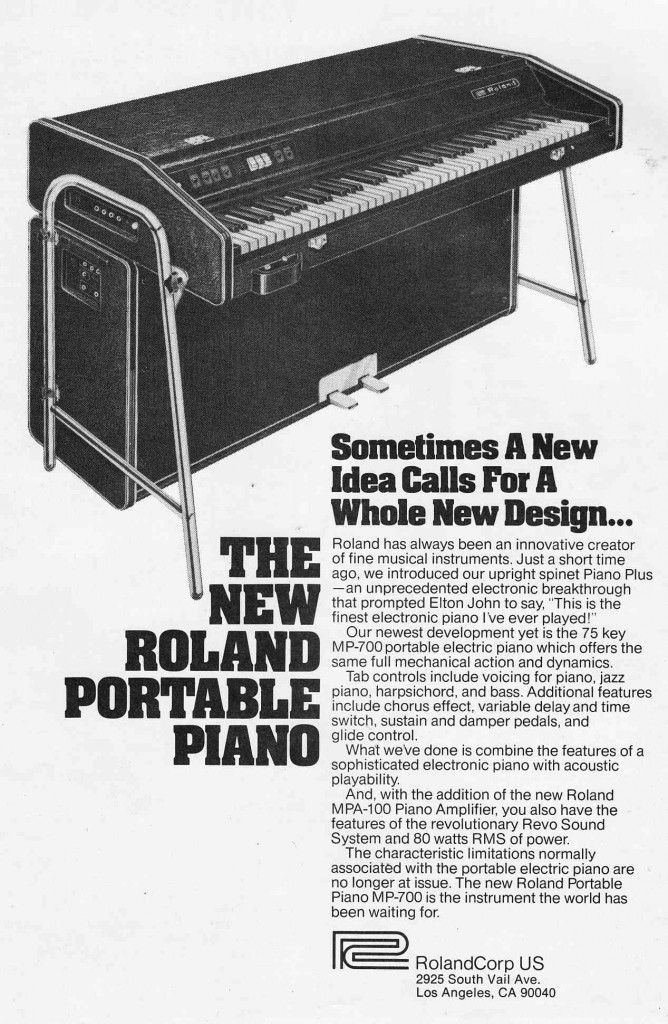 Roland MP-700 electronic piano
Roland MP-700 electronic piano
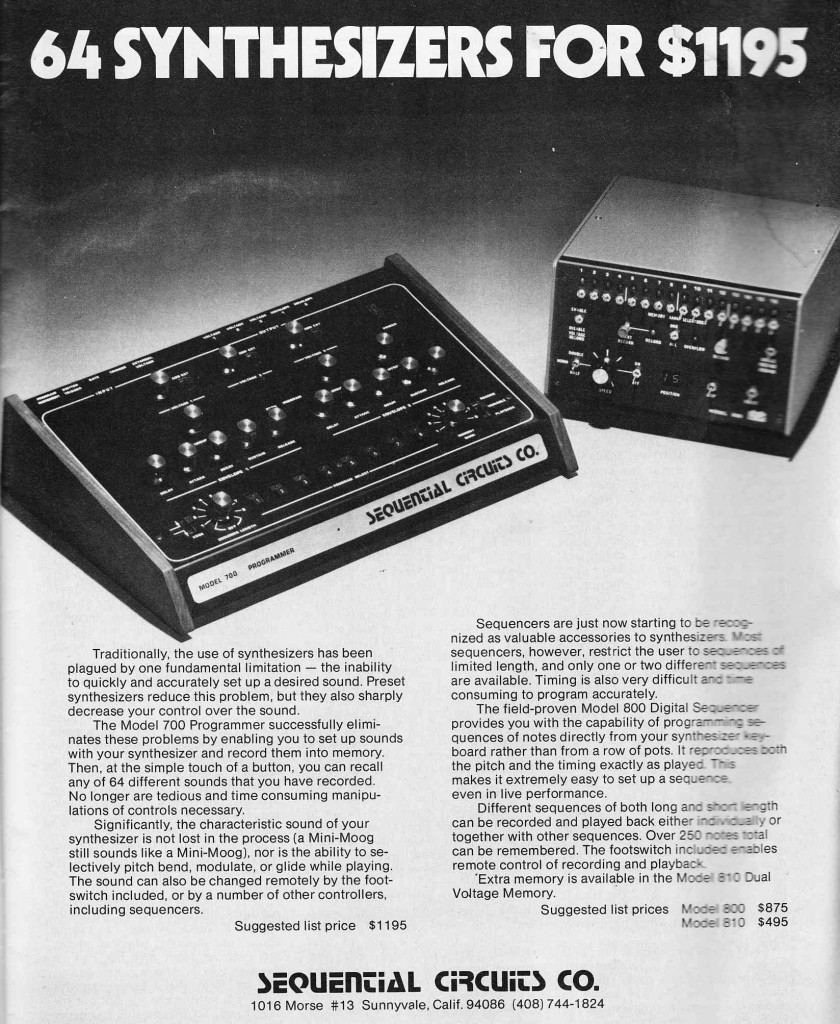 Sequential Circuits Model 700 programmer. I assume that this thing has a bunch of jackpoints that you would connect to various I/O points on yr modular synth… anyone use one of these?
Sequential Circuits Model 700 programmer. I assume that this thing has a bunch of jackpoints that you would connect to various I/O points on yr modular synth… anyone use one of these?
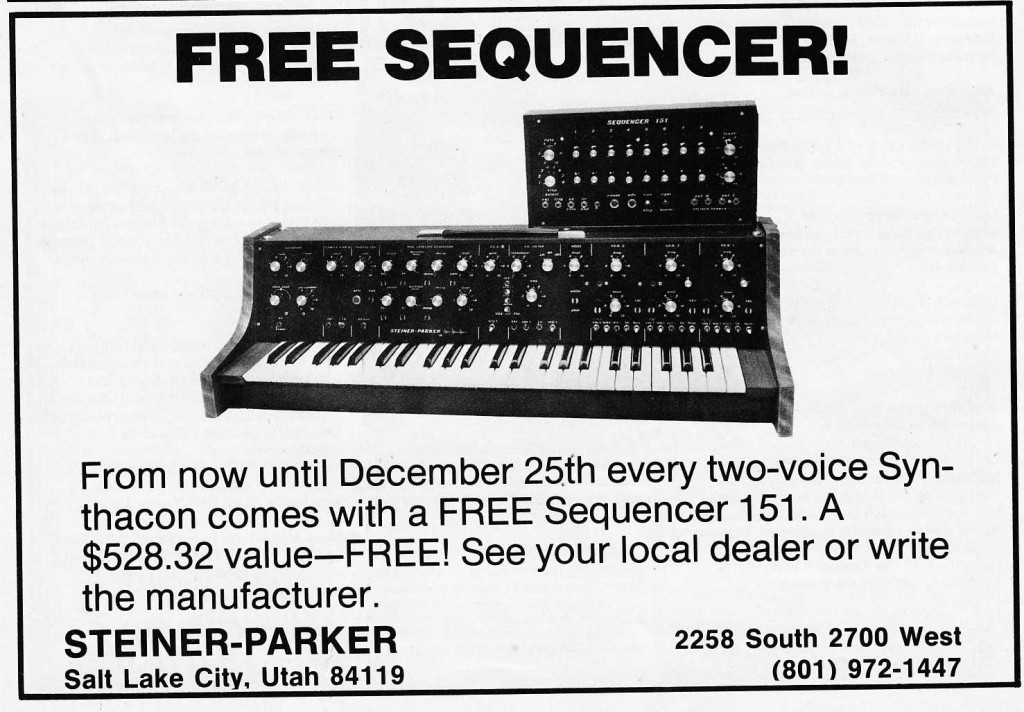 The Steiner-Parker Synthacon. A rare Minimoog-esque unit. Apparently used on IN THE LIGHT.
The Steiner-Parker Synthacon. A rare Minimoog-esque unit. Apparently used on IN THE LIGHT.
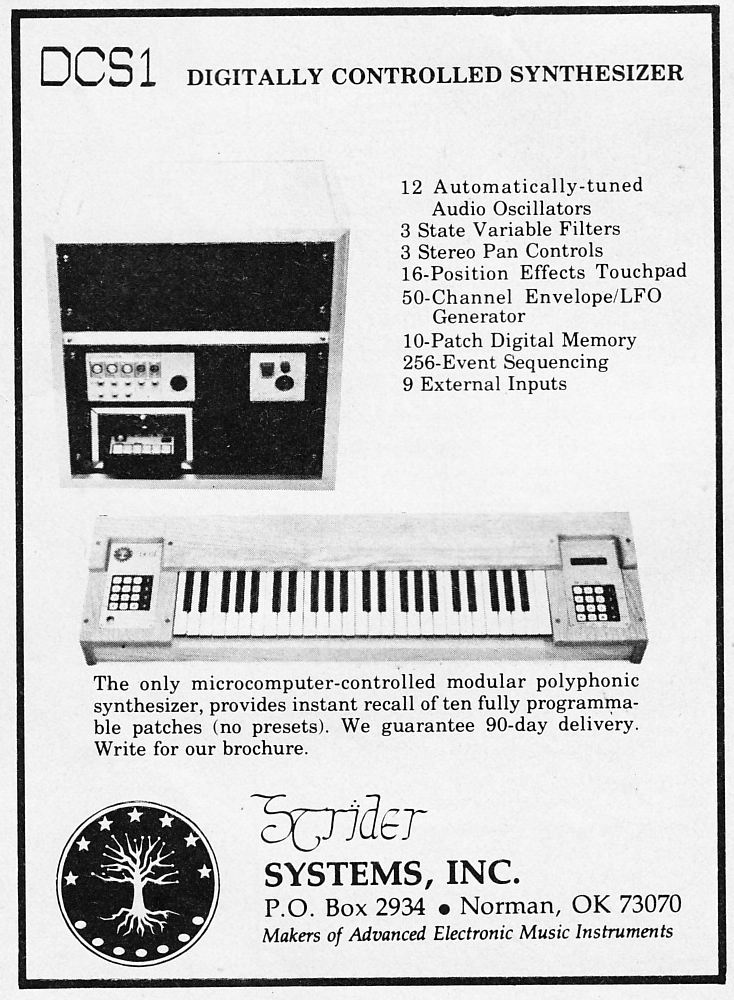 The Strider Systems DCS1. I can’t find any info on this piece. Anyone?
The Strider Systems DCS1. I can’t find any info on this piece. Anyone?
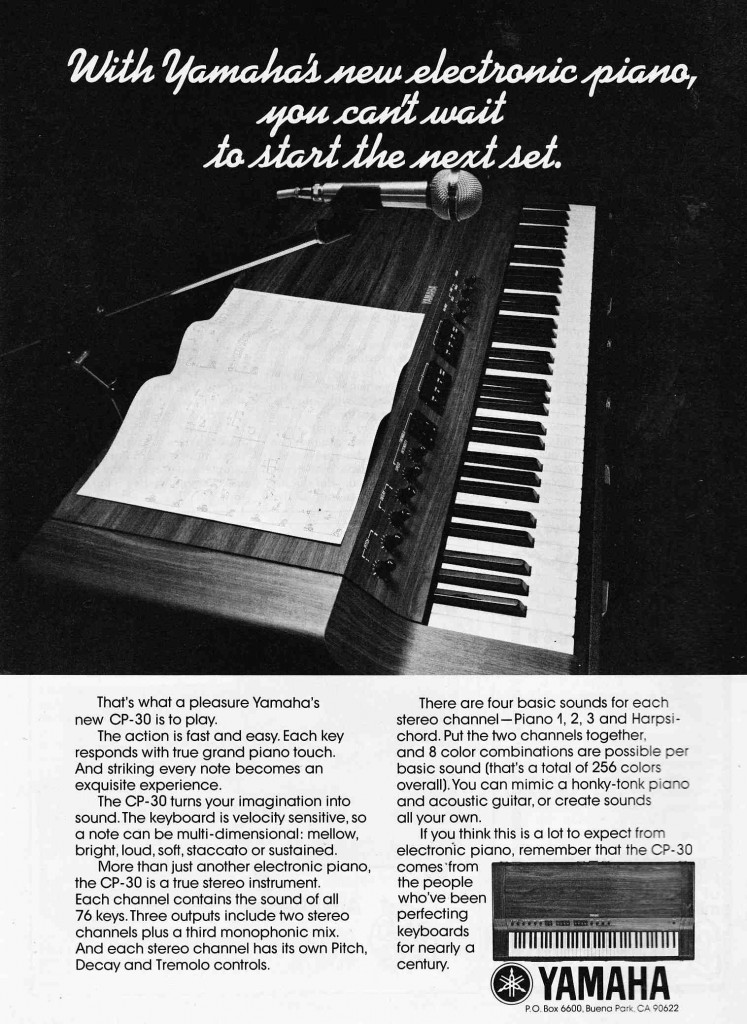 Yamaha CP-30, yet another electronic piano
Yamaha CP-30, yet another electronic piano
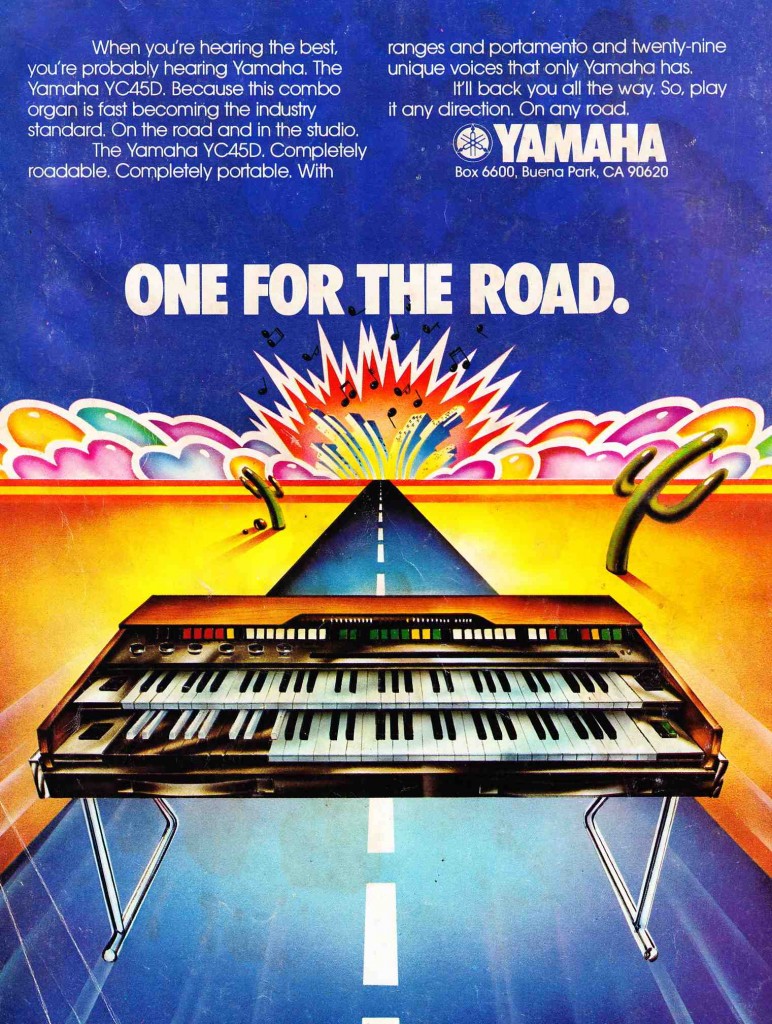 The Yamaha YC-45, the flagship model of their YC series. The YCs are unapologetic “Combo Organs,” which explains why they are still in use while the string synths and electronic pianos rest mainly in landfills. These are great-sounding, versatile organs; they also weigh a metric tonne so be forewarned.
The Yamaha YC-45, the flagship model of their YC series. The YCs are unapologetic “Combo Organs,” which explains why they are still in use while the string synths and electronic pianos rest mainly in landfills. These are great-sounding, versatile organs; they also weigh a metric tonne so be forewarned.
Want more? Check out this site; this man has dedicated his entire blog to territory that I only dare visit.
Tomorrow: some interesting keyboard amps and FX from the era.
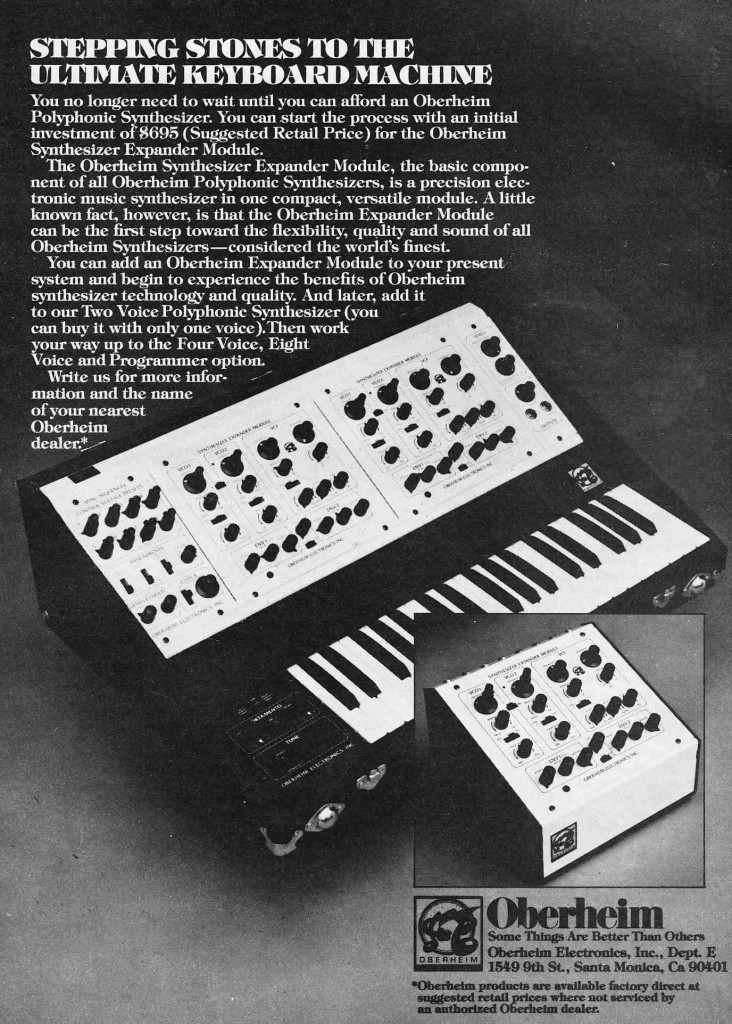
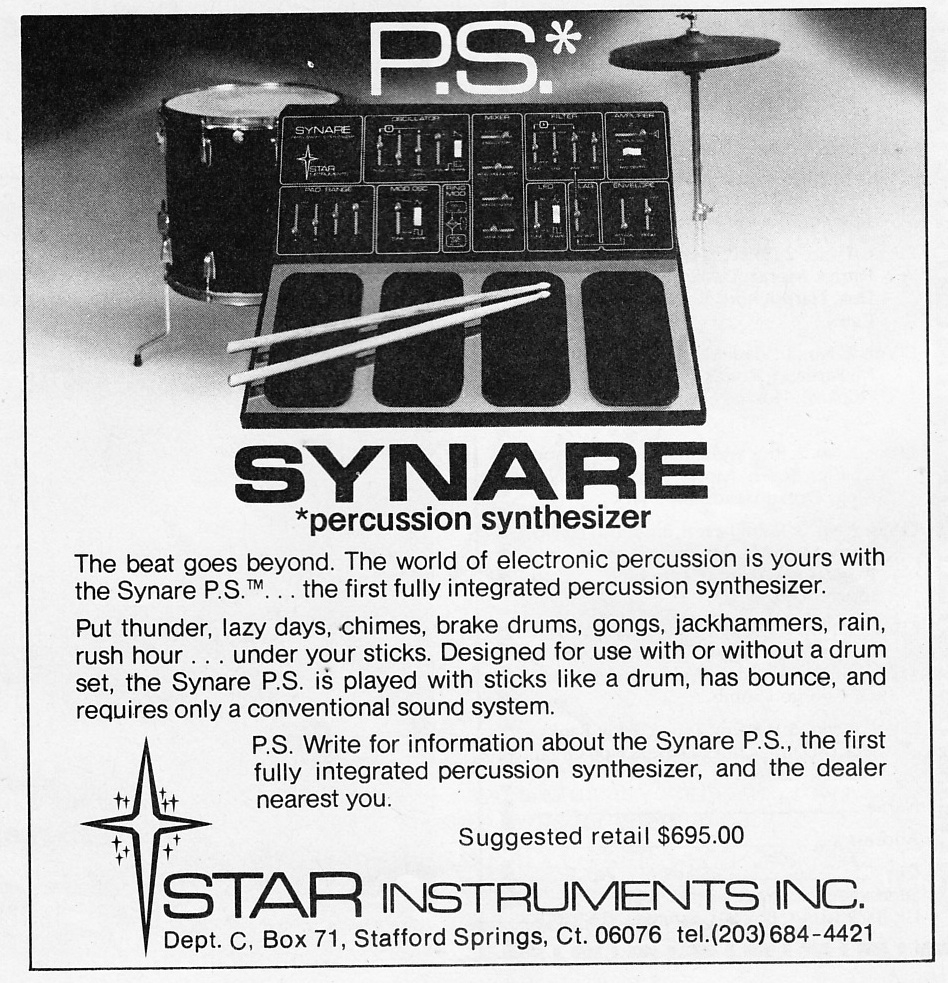
14 replies on “Keys of the 70s”
ISTR that Eddie Jobson used the Sequential Circuits programmer and sequencer with his Mini-Moog with U.K. I’m pretty sure that’s where the ostinatos on pieces like “By the Light of Day”, “Alaska”, “Nevermore”, and “Carrying No Cross” come from.
Lemme see here…
RMI KC-II : I had one of these in my pro audio shop (Don Wehr’s Music City in S.F.) around 1981. It was based on Allen Digital Organ technology, and used computer punch cards(!) to write voices. In fact, it was brilliantly simple: if you’ve ever seen an old computer punch card, there are rows of numbers with tiny rectangular perforations on each number. (There are voting machines that still use these – remember the “hanging chads” of the 2000 USA election?) To create a custom wave form, you simply drew the shape of the wave on the card over the perforations, then punched out the chads to make a kind of “connect-the-dots” waveshape, and that is what the KC would read into it’s wave memory. I actually tried this and it worked – I made a square wave, a saw wave and a “crazy” wave (random holes punched out.) So it’s not so much a RAMpler as it was a wavetable synth. The card could only do a few wave cycles so it was kind of limited.
Also, Don Wehr’s had a School of Music, and I was the synth teacher. I had a Moog System 35 modular, an Oberheim 4-Voice with programmer and an ARP Odyssey in the electronic music studio, along with a TR-808 drum box, and both of those Sequential Circuits units. The 700 Programmer was simply a CV and envelope generator that you connected to your analog synth’s control jacks. There were three CV outputs meant to control the initial settings of the VCO, VCF and VCA. So you would set the controls on the synth to minimum values (e.g. turn the VCF cutoff all the way down) and the 700 would send “more” voltage to cause the VCA or VCF to open, or modulate the VCO. The trickiest thing was the trigger system (which was switchable between V-trig or S-trig). You fed the trigger output from your synth into the 700, which had two of it’s own 5-stage DADSR envelope generators. So you left the synth’s envelope amounts zeroed out and controlled the note dynamics from the 700’s panel. It was a great add-on for a Minimoog because the envelopes were much more capable than the Mini’s ADS(R)s.
It wasn’t all that accurate in use, since the initial settings of the synth were very important, one knob did all the CV (including octave settings), and it couldn’t set waveforms, sync, glide, or mixes of the sound sources. So in practice it saved you some dial turning on the synth it was controlling, but it was not the same as a real programmable synth (like their later Prophet 5) or even as capable as the Oberhiem 4-Voice Programmer. Consequently it didn’t sell all that well (not for $1200 1977 dollars.) Oberheim’s DS-2 sequencer was much easier to use than the SC 800 too.
Nice commentary – accurate thanx, Joey
Incredible collection – THANK YOU!! Such amazing memories. I recall coming VERY close to buying the PAIA 4700 kit, but my guitarist (who was a much better solderer) thought I was crazy and talked me out of it. Ended up with an Octave Cat (fantastic), a Crumar Orchestrator (good when I wasn’t re-gluing key contacts in place), and a Hammond X-2 portable. But always wanted, and couldn’t afford, the RMI Keyboard Computer II, and would buy one today if anyone is selling.
I am an electronic technician/musician, and I am currently restoring an RMI Keyboard Computer II. The instrument itself is in very good condition,considering its age.I have replaced all components that can have age related issues, [ electrolytic capacitors and card reader lamp bulbs]and have cleaned/de-oxidized every contact,switch,connector, and control. I am about to put it up for sale on ebay, with Los Angeles,Ca. local pickup only.I would consider shipping it anywhere, for the right price–but I believe it would be very expensive due to it’s weight and packaging concerns.
Hello Charles,
is your RMI keyboard computer still available ? I am very interested in buying it if it is still available ? Do you also have any of the foot pedals ? Do you have any of the original punch cards ? What ballpark price are you looking for ? I know a good white glove courier, Hedleys, who I use regularly who can pick it up and also pack it for for me . Would you accept payment by bank wire ?
Please let me know I am a serious buyer and not a time waster.
You can check my ebay profile ‘electronicperriand’ to check my feedback rating.
Many thanks in advance for your kind help.
Kind regards.
Sean Bentley
Hi Charles;
Have you ever worked on the RMI Keyboard Computer first version?
I have one and I am looking for someone familiar with their basic design that can trouble shoot it!
Thanks!
Hello,
does anyone out there have a working RMI Keyboard computer 2 for sale ? I am a serious buyer and not a time waster and can organize courier pickup. If anyone can help I would really appreciate it.
Many thanks in advance.
Best regards.
Sean
I have one still in excellent condition with the foot pedals and leslie hookup.
Just do not use it anymore along with my Hammond X5.
Hi Don,
is your RMI keyboard computer for sale ? Is it the KC-1 or KC-2 ? Do you have any of the original tone cards with it ? Please contact me to discuss.
Many thanks in advance.
Warm regards.
sean_bentley1@hotmail.com
Hello,
I am still looking for an RMI keyboard computer 2 complete with pedal board. Does anybody out there have one for sale ?
Many thanks in advance for your help.
Warm regards.
Sean
Did you ever find your KCII? No, I don’t own one – but I did at one time…and the Harmonic Synth as well. I helped a little with some sounds for the KCII – and they were kind enough to place the KCII chip in my KCI. I also had presets custom made for my KCI and they gave me the lighted buttons from a HarmpnicSynth to utilize. I’ll send you some pics if you want? What did the KC sound like? Great organ, bells – and with some chorusing added, super strings. The Harmonic synth wasn’t much of a stage instrument – I ended up trading mine back to the dealer in exchange for one of the first Prophet 5’s(#38). It worked for about 10 years and then died a complete death. The RMI was still working…I sold mine for about $3000 to a collector in Washington State.
I like the ad showing that you could drop the RMI Electra piano. Look at close up pictures of Ian Hunter’s circa 1970-1971 and it looks like it was thrown in the roadway and run over by trucks. There is even a story that appeared in The Horse’s Mouth that Ian Hunter kicked the piano into the audience in Detroit once. Mike Davis told me this story from a first person account and it showed up again in the Horse’s Mouth from another person, so it is probably true. They must have been rugged.
[…] Keys of the 70s […]